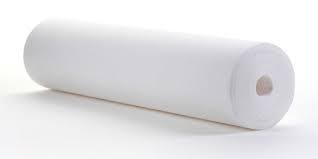How does melt blown work?
Non-woven fabric styles will vary greatly depending on the composition. The making of non-woven fabrics involves a variety of industrial techniques. The melt-blown method is used to create non-woven fabrics. High-temperature, high-speed air jet blowing or other methods are used to create extremely tiny fibers from the polymer melt that the screw extruder has just extruded. These fibers then collect on the web-forming drum or web curtain. A fiber web forms, and it is ultimately made into a melt-blown fiber non-woven fabric by self-adhesive action, which strengthens the web.
Polypropylene makes up the majority of meltblown non-woven fabric, and the fiber diameter can range from 1 to 5 microns. Numerous voids, a fluffy texture, and strong anti-wrinkle properties are present. The quantity and surface area of fibers per unit area are increased by these ultrafine fibers with special capillary structures, giving the meltblown fabric better filtration, shielding, heat insulation, and oil absorption. It can be applied to wiper cloths, air filters, liquid filters, isolation materials, absorbent materials, mask materials, thermal insulation materials, and other items.
The meltblown layer's fiber diameter is barely a tenth of the spunbond layer's diameter since it is so thin—roughly 2 microns (um). The melt-blown layer's ability to prevent the entry of small particles increases with its fineness. KN95 masks, for instance, refer to The small particles (0.3um) play a crucial function in filtering microorganisms and preventing blood penetration, which is why they are known as the heart of a mask. Under typical conditions, a flow of 85L may block 95% of these tiny particles.
Production of non-woven melt blown fabrics using a traditional method
Input polymer → melt extrusion → fiber formation → fiber cooling → web forming → bonding (fixed web) → trimming and winding → finishing or special finishing
Input polymer —— PP polymer raw materials are typically cut into tiny, granular or spherical slices before being loaded into a barrel or hopper and fed into the screw extruder.
Melt extrusion —— The polymer chips should be thoroughly stirred and mixed with stabilizers, brighteners, and other additives as well as necessary raw ingredients like masterbatch before entering the screw extruder and being heated to a high temperature. into a melt, and then the metering pump sends the melt via the filter to the spinneret. The universal extruder additionally employs its shearing and thermal degrading effects throughout the melt blown process to lower the molecular weight of the polymer.
Fiber formation —— In order to ensure that the extrusion volume of each spinneret hole is constant, the filtered clean melt will move through the distribution system before being evenly distributed to each group of spinnerets. In contrast to conventional spinning techniques, the spinneret of meltblown fiber has high-speed air jet holes on the upper and bottom sides, and the holes must be organized in a straight line.
Fiber cooling —— On both sides of the spinneret, a sizable volume of ambient air is simultaneously drawn in, mixed with the hot air stream holding the ultra-fine fibers to cool it down, and then the molten ultra-fine fibers are cooled and solidified.
Netting —— The spinneret can be positioned either horizontally or vertically when making nonwovens out of meltblown fiber. If put vertically, the superfine fibers fall into a horizontally moving web-forming curtain to condense into a web; if placed horizontally, the superfine fibers are sprayed on a circular collecting drum to form a web.
Adhesion (fixed net)—— For various uses of melt blown cloth, such as when the fiber net needs to have a reasonably fluffy structure, a high rate of air retention, or porosity, the self-adhesive reinforcement indicated above is sufficient. Self-adhesive reinforcement alone is insufficient for many other uses. Additionally necessary are hot-roll bonding, ultrasonic bonding, or other types of reinforcement.
Connect a member of GREENCARE right away for more details on our services.

